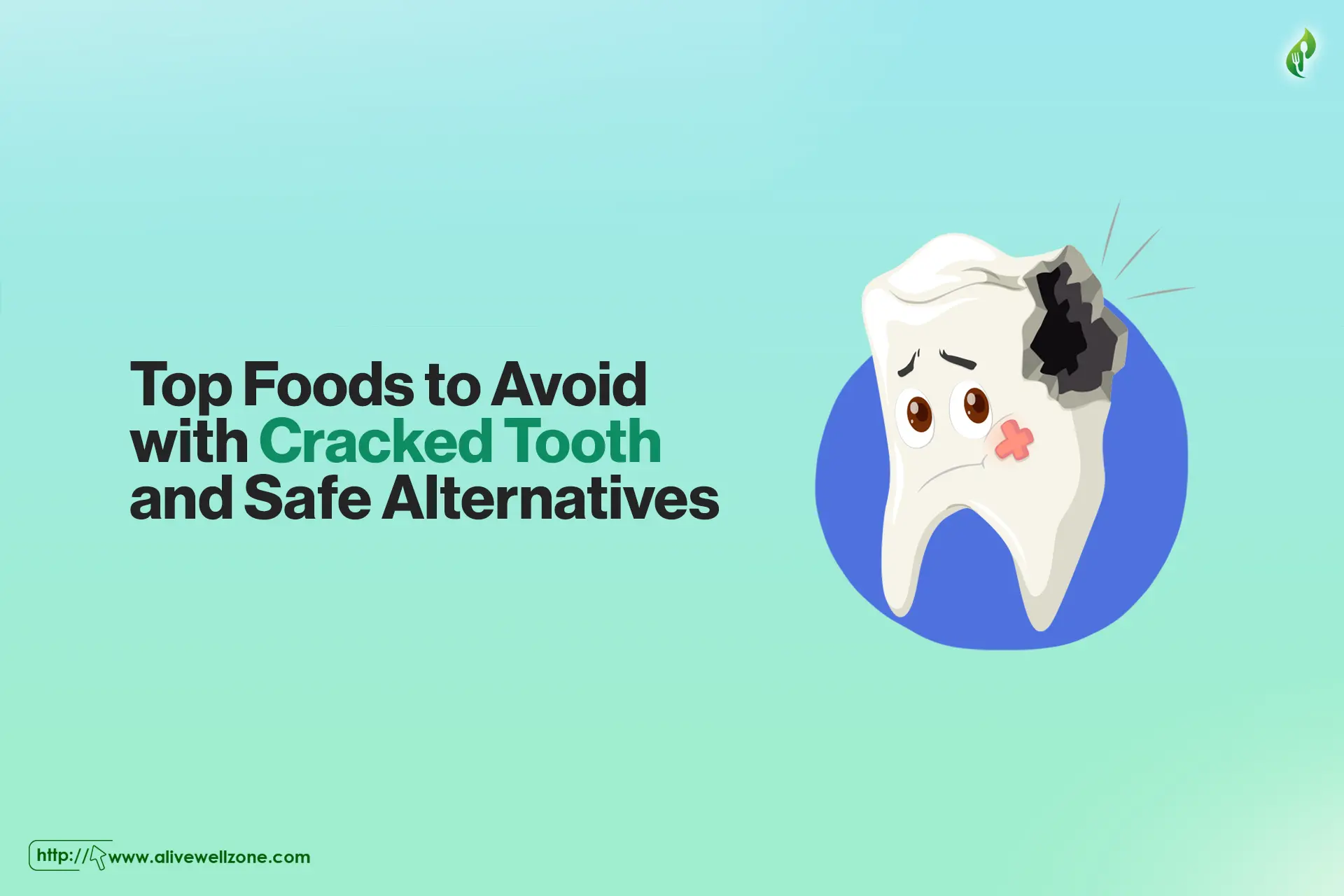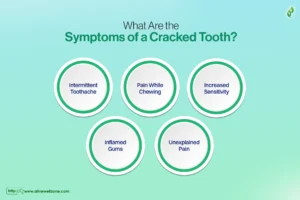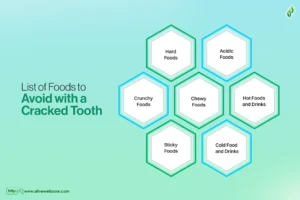
Last Updated on November 8, 2024 by Helena Akter
Let’s face it, a cracked tooth can be a real pain. Not only is the constant pain annoying, but you also need to worry about what you can and can’t eat.
Foods to avoid with cracked tooth include nuts, hard candies, toffee, acidic foods, caramel, and hot or cold foods. These can make your condition worse, leading to more pain and damage.
Stay with us, and we’ll guide you through the foods you should avoid and the ones you can eat. Plus, we’ll share tips on foods that can keep your teeth healthy. Let’s get started.
Key Takeaways
- Foods to Avoid with a Cracked Tooth: Avoid hard foods like nuts, popcorn kernels, crunchy raw vegetables, hard bread, sticky caramel, and toffee. Also, stay away from very hot or cold foods and drinks.
- Foods to Eat with a Broken Tooth: Choose soft foods like steamed carrots, peas, bananas, peaches, tofu, eggs, yogurt. Also, you can opt for blended soups, minced meat, jelly, pudding, oatmeal, and mashed potatoes.
- Foods to Keep Teeth Healthy: Drink water and sugar-free drinks, chew sugar-free gum to increase saliva, eat citrus fruits to increase saliva flow. Plus, consume cheese and milk for enamel protection, and include omega-3 foods like fish and flaxseed to reduce inflammation.
What Causes Cracked Teeth?
There are several reasons why your teeth might crack. Here they’re, broken down for you —
- Trauma: If you’ve had a hit to your face or mouth, it could cause your teeth to crack.
- Hard Foods: When you bite into hard foods like ice, bones, nuts, or candies, it can cause your teeth to crack.
- Teeth Grinding: If you have a habit of clenching or grinding your teeth, a condition known as bruxism, it can lead to cracks over time.
- Age: As you get older, your teeth naturally become weaker and more prone to cracking.
- Large Fillings: If you have large dental fillings, they can weaken the structure of your teeth, which might lead to cracks.
- Sudden Temperature Changes: If you frequently switch between hot and cold foods or drinks, it can cause your teeth to crack.
What Are the Symptoms of a Cracked Tooth?
Spotting a chipped tooth while eating can be tricky. However, certain symptoms can help you identify the problem.
Here are some key signs to look out for —

Intermittent Toothache
One common sign of a chipped tooth is a toothache that comes and goes. You might experience pain for a bit, then it fades, only to come back later. This fluctuation in pain is due to the nerve inside the tooth getting exposed by the chip, but not always being irritated.
Pain While Chewing
Another symptom is discomfort when you bite down on something hard or chewy. If you feel pain in a specific area while chewing, it could suggest a chipped tooth in that part of your mouth, even if you can’t immediately identify the exact tooth.
Increased Sensitivity
A chipped tooth can lead to sensitivity rather than outright pain. If you feel a sharp sensation when exposed to cold, heat, or sugar, it might point to a hidden chip.
It occurs because the chip exposes the nerves inside the tooth, which are usually shielded by the enamel.
Inflamed Gums
If you have a cracked tooth, it’s more likely to get infected. Bacteria can slip through the crack and infect the dental pulp inside your tooth. This infection can cause your gums to swell up and become sensitive.
In some situations, you might even notice abscesses or bumps appearing on your gums.
Unexplained Pain
If you’re experiencing pain that’s hard to pinpoint, it could be a sign of a cracked tooth. This kind of pain can spread across one side of your mouth, rather than being confined to a single tooth. It might seem random and without an obvious cause.
List of Foods to Avoid with a Cracked Tooth
If you have a cracked tooth, some foods can worsen the condition, leading to more pain or additional damage. Here are the main types of foods you should avoid —

1. Hard Foods
Foods like nuts, bones, hard candies, and unpopped popcorn kernels can exert too much pressure on a cracked tooth. When you bite into these, they can exacerbate the crack or create new fractures.
On top of that, Popcorn kernels are particularly problematic as they can be concealed within the fluffy parts.
2. Crunchy Foods
Foods that are crunchy, such as hard bread, raw vegetables, and hard fruits, require a lot of chewing. So, usually it can strain the cracked tooth and intensify the damage.
While cutting these foods into smaller pieces can help, it’s best to avoid them until your tooth is repaired.
3. Sticky Foods
Sticky foods like toffee, caramel, and gummy candies can stick to a cracked tooth. Chewing these can tug at the tooth, worsening the crack or causing more pain.
These foods can also become lodged in the cracks, leading to decay if not cleaned properly.
4. Cold Foods and Drinks
Items like ice cream and cold sodas can trigger sharp pain due to temperature sensitivity. These foods irritate the sensitive nerves within the tooth like the Tooth Pulp. Ultimately, it can unspeakable cause pain preventing you from eating even regular foods.
5. Hot Foods and Drinks
Like cold foods, eating hot foods or drinking hot beverages can make your teeth more sensitive and cause more pain. It’s better for you to have your food and drinks at a comfortable temperature.
6. Acidic Foods
Acidic foods like citrus fruits, vinegar, chili and tomatoes can harm your teeth by irritating the nerves and weakening the enamel. It’s a good idea to limit these foods or rinse your mouth after eating them.
7. Chewy Foods
Hard meats and chewy bread can put pressure on a cracked tooth, making the crack worse or even causing new ones. It’s recommended to choose softer foods or cut your food into smaller pieces. However, it’s best to avoid these foods until your tooth is fixed.
What to Eat with a Broken Tooth?
If you’re dealing with a broken tooth, it’s crucial to pick foods that won’t worsen the pain or cause more damage. Here are some easy-to-eat food options for you —

1. Soft Vegetables
Think about soft veggies like carrots, peas, green beans, spinach, and broccoli. Just make sure to steam or boil them until they’re soft enough for you to chew easily.
2. Soft Fruits
There are soft foods to eat with broken tooth that don’t need much chewing. You have options like bananas, grapes, peaches, and watermelons are all good choices.
3. Tofu
It’s a soft food that’s also packed with protein. It won’t hurt your broken tooth, and you can add it to soups or blend it into smoothies for a nutritional boost.
4. Eggs
They’re soft and easy to eat in any form – scrambled, poached, or boiled. They require little chewing, which makes them a good choice for you.
5. Dairy Products
Soft dairy foods like yogurt, milk, and cottage cheese won’t harm your teeth. Plus, they’re full of important nutrients. You can enjoy them on their own or add them to smoothies.
6. Blended Soups
These are soothing and easy for you to eat. You can pick from options like chicken cream soup, pumpkin soup, or potato soup. Just remember to let them cool down a bit to prevent any discomfort.
7. Minced Meat
Minced meat is easier to chew than larger pieces. You can add it to pasta or shape it into meatballs for a meal that’s gentle on your teeth.
8. Jelly or Pudding
If you have a sweet tooth, opt for low-sugar puddings or jelly. These soft desserts won’t require much chewing, making them a comfortable choice.
9. Oatmeal
Oatmeal is a soft and nutritious food that’s easy to eat. For a creamier texture, you can add milk. Top it with soft fruits like mashed bananas or berries for added flavor.
10. Mashed Potatoes
Mashed potatoes are soft, filling, and easy on your teeth. Just add a bit of butter, salt, and pepper to enhance their taste.
Foods to Choose for Healthy Teeth
Having discussed what to eat and avoid when your tooth is cracked, let’s look at some foods that can help your teeth stay healthy.
- Water: Water is the best way to quench your thirst and it also helps wash away acid-producing foods, keeping your mouth clean.
- Sugar-free Chewing Gum: It increases the flow of saliva, which neutralizes acids, protects your enamel, and cleans food particles from your mouth. It’s a great choice when you’re craving something sweet. Remember, chewable toothpaste can maintain your oral health and prevent further damage.
- Sugar-free Drinks: These drinks can help rinse away acid-producing foods, reducing the risk of cavities. They offer a sweet alternative to water.
- Citrus Fruit: Even though they’re acidic, citrus fruits like oranges and grapefruits can increase saliva flow and protect your enamel. Their high water content also helps rinse away bacteria.
- Cheese and Milk: These dairy products increase saliva production, which helps neutralize acids in your mouth. Its protein, calcium, and phosphorus content buffers acids and protects enamel. Research even suggests that cheese and milk might strengthen the minerals on the surfaces of your teeth.

- Omega-3: Omega-3 fatty acids, which you can find in fish, fish oil, and flaxseed, are great for reducing inflammation and infection. They can help lower your risk of gum disease.
- Fish and Flax: Eating fish and flax can help fight inflammation and protect you against gum disease. Gum disease happens when bacteria cause inflammation that can harm the tissue that holds your teeth to your bone.
- Cocoa: Cocoa contains substances that can reduce inflammation and help protect your teeth from erosion and decay. Dark chocolate, which has less sugar, is a better choice. Even chocolate milk, despite having some sugar, is a healthier snack option than cookies and chips.
Final Words
Dealing with a cracked tooth isn’t easy. So, you must stay away from foods that are hard, crunchy, sticky, or extreme in temperature. Plus, acidic foods can also cause more harm and pain.
Choosing softer foods can make a big difference. Think about options like steamed veggies, soft fruits, and dairy products. These can help protect your teeth and aid in healing.
In the long run, a diet that’s good for your teeth can be really helpful. We suggest you keep learning about the foods to avoid with cracked tooth for strong and healthy teeth. Thus, you’ll be better able to handle your cracked tooth and keep your teeth healthy.
FAQs
Is milk good for cracked teeth?
Yes, the calcium in milk helps keep a cracked tooth moist and alive, enhancing the chances of saving it and avoiding dentures, crowns, or implants. Immediate treatment is crucial to prevent nerve death, abscesses, or the need for extraction.
Will I always need treatment for a cracked tooth?
Yes, treatment is necessary for a cracked tooth to prevent nerve damage, abscesses, and tooth loss. In fact, untreated cracks can worsen, potentially requiring root canals or extractions. Early treatment improves effectiveness and preserves the tooth.
Can I eat with a chipped tooth?
Yes, however, avoid using the chipped tooth for chewing until it is fixed. You should stick to soft foods and wear a mouth guard if playing sports or grinding your teeth at night to prevent further damage.







